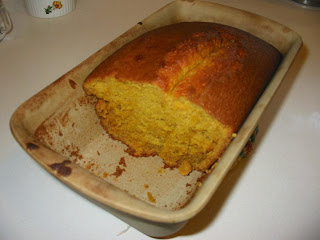Take a nice little pie pumpkin and hack into that practically impenetrable outer flesh. Then grab a spoon and scrape at the hard innards trying to pull the seeds out.
OR.....
Take a look at that gorgeously cured, solid pumpkin.
Wash off the dirt.
Put it on parchment paper (easier cleanup) in a jelly roll pan. And bake at 400-degrees. Start checking it with a fork after about 30 minutes. Its ready when the fork easily pierces the skin and the flesh feels really soft.
Let the pumpkins completely cool.
Cut the pumpkin in half.
Oooh, like slicing through butter!
Scoop the seeds and strings out of the nice soft flesh.
You can save the seeds for roasting. Or, if you have soooo many (like me) you can feed them to your pigs and chickens. I've read that the seeds act as a natural dewormer. Bonus! Extra feed and natural medicine!
Scoop the flesh from the pumpkin. You may need to slide your spoon between the hardened skin and the flesh, but its so simply done.
Throw the flesh in the food processor and puree until smooth.
Done! I put four cup portions of the pureed pumpkin in freezer bags and freeze it for winter treats and use some to make delicious pumpkin bread.
A neighbor gave me this recipe about twenty years ago. It makes a really smooth, rich pumpkin bread. Yum!
Pumpkin Bread
3 c. sugar
4 eggs
1 c. oil
2/3 c. water
2 c. pumpkin
1 c. chopped nuts (optional)
3-1/4 c. flour
1-1/2 tsp. salt
1 tsp. cinnamon
scant 1/2 tsp. nutmeg
1/2 tsp. allspice
2 tsp. baking soda
Put sugar in bowl, add eggs and cream together.
Add oil, water, and pumpkin.
Add dry ingredients. Mix well.
Put in greased loaf pans. Bake at 350-degrees for about 60 minutes.
Makes 2-3 loaves (size 5-1/2x8x2)
Enjoy warm with butter!



















